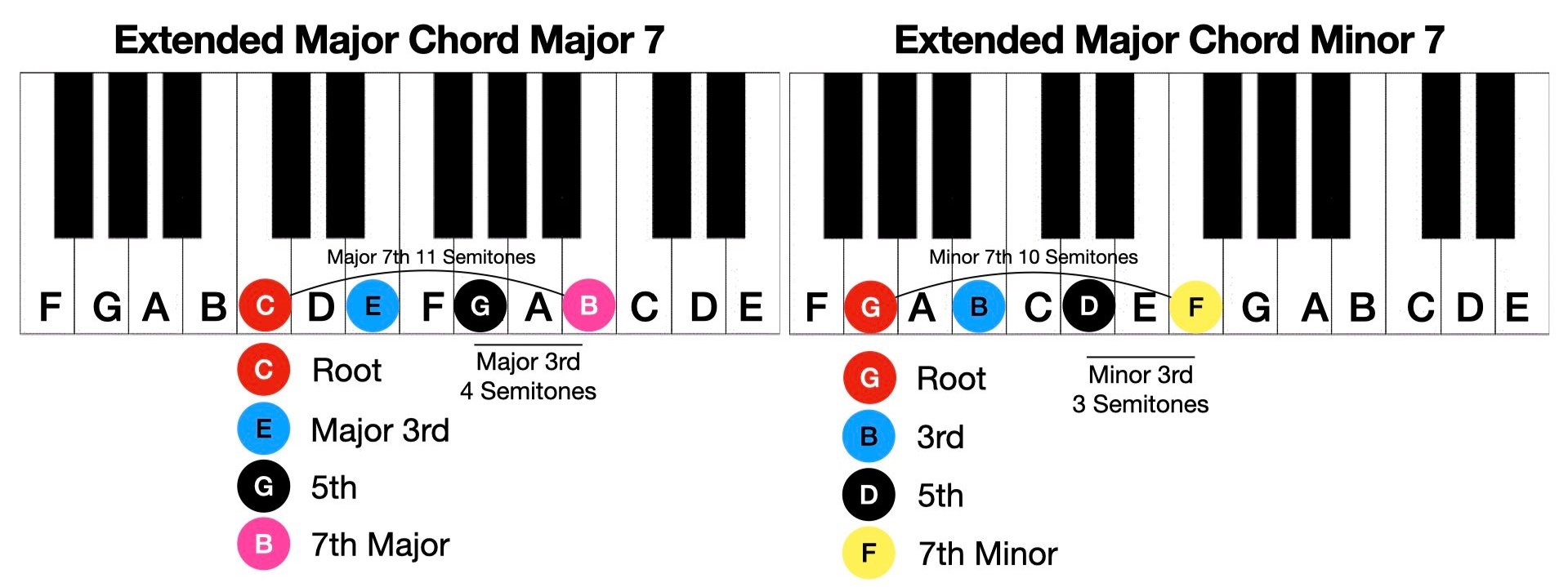3. Chord Inversions and Chord Extensions
Chord inversions and extended chords add to the mood and emotion of a chord progression. In this article we will learn about 1st and 2nd chord inversions and extended chords including 7th, half-diminished, and augemented chords as well as the power chord.
Chord Inversions
Chord inversions are a simple concept where an inverted chord has its lowest tone as a note other than the root tone. Any type of chord can be inverted. The most common inversions are 1st inversions and 2nd inversions. Another way to look at chord inversions is treat them as chord voicing.
1st Inversions Chords
First inversions chords have the 3rd as the lowest note. The diagrams below show two forms of the 1st inversion chords with the triads of 3rd, 5th, root, and with the 3rd, root, 5th.
2nd Inversions Chords
Second inversions chords have the 5th as the lowest note. The diagrams below show two forms of the 2nd inversion chords with the triads of 5th, root, and 3rd, and with the 5th, 3rd, root.
The function of chord Inversions are important for composition and performance. Each inversion has a subtile different sound from the root position chords. And when moving from one chord to the next in a chord progression, movement between different chord inversions (or chord voicing) opens up new opportunities for emotion, melody, and themes in a piece. In a performance, the use of chord inversions maybe used for an economy of movement and/or to enhance the melody. Inversions are used in all forms of music and played on almost all instruments. In the next Blog we will explore chord voicing (inversions) for the piano as well as guitar.
7th Chords (Major 7th and Minor 7th)
There are two types of 7th chords, a major 7th and a minor 7th. These chords fit in the diatonic major scale in this manner:
- I and IV major chords form a major 7th chord. This is created by moving diatonically up a major 3rd above the 5th.
- V chord becomes major chord with a minor 7th. The V7 chord is called a dominent 7th chord. This is created by moving diatonically up a minor third above the 5th for the V chord.
- The minor ii, iii, and vi, chords each form minor 7th chords. The 7th is a minor 3rd above the 5th.
- The viiø, forms a half-diminished chord and is made up of all minor 3rd intervals (R, m3, b5, m7).
If we look at the relationship of the chords and the scale degrees, we get the diagram below. This diagram shows how the tones of each diatonic 7th chord relate to the major scale where we use the C Major scale for reference. Also, shown are individual chord tones to the major scale degrees .
If you are interested in diving deeper into 7th chords click the link below.
Suspended Chords
Suspended means that the 3rd of the chord has been replaced by either the 2nd or the 4th tone of the scale.
Suspended (Sus) 2 chord has the 3rd replaced by the major 2nd tone.
Sus 4 chord has the 3rd replaced by the Perfect 4th.
Suspended chords are very useful because they are neither a major or a minor sounding chord. They add some suspense into a chord progression.
Augmented and Power Chords
Augmented chords are major chords formed by raising the 5th one semitone (augmented 5th). This chord is a major chord formed from stacked major 3rds. It sounds unstable and can add tension or conflict in a chord progression.
Power chords are just the root tone and the perfect 5th tone or a dyad and not a triad. These chords are very import in rock music and are neither major or minor. Power chords are commonly played on the guitar and the octave of the root may be added as the top tone.
Closing
So, this article demonstrated spelling 7th chords, suspended chords, augmented chords, and power chords. We covered a lot of material but what we learned will prove useful and important as we begin to discuss chord progressions and songwriting which is an overall goal of this series. Understanding how the different chord combinations can create a happy or a sad feeling. How, creating tension and release through chord voicing, extensions, and using other tools can raise a song to a new level.
In the next blog we will look at the guitar and how all of this works. While the piano is a great tool for visulally demonstrating musical intervals, most singer-songwriters write songs using the guitar. Following that the series will move into discussing chord progressions.





